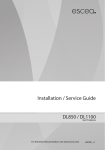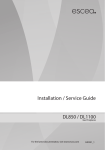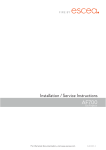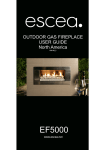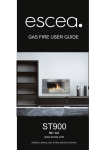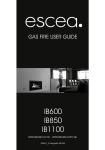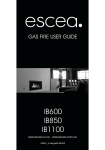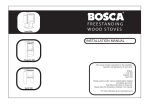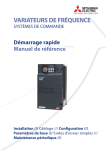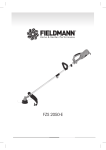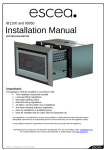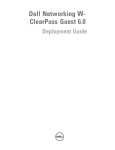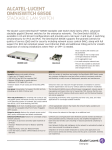Download User Guide
Transcript
User Guide AF700 Gas Fireplace For the latest documentation, visit www.escea.com 630307_2 ! WARNING If the electrical cord is damaged, it must be replaced by the manufacturer, its service agent or similarly qualified persons in order to avoid a hazard. The data label for this appliance, containing technical information and specifications, can be found adhered to the metal work under the burners. DO NOT PLACE ARTICLES ON OR AGAINST THIS APPLIANCE. DO NOT USE OR STORE FLAMMABLE MATERIALS NEAR THIS APPLIANCE. DO NOT SPRAY AEROSOLS IN THE VICINITY OF THIS APPLIANCE WHILST IN OPERATION. NEVER OPERATE THE FIRE WITH THE FRONT GLASS REMOVED. IT IS NOT RECOMMENDED TO OPERATE THE FIRE WITH THE FASCIA PANELS REMOVED. (DL850 only) THE APPLIANCE MUST BE INSPECTED BEFORE USE AND SERVICED AT LEAST ANNUALLY BY AN AUTHORISED TECHNICIAN. THIS APPLIANCE MUST BE INSTALLED IN ACCORDANCE WITH THE MANUFACTURER’S WRITTEN INSTRUCTIONS. THIS APPLIANCE IS NOT INTENDED FOR USE BY YOUNG CHILDREN OR INFIRM PERSONS UNLESS THEY HAVE BEEN ADEQUATELY SUPERVISED BY A RESPONSIBLE PERSON TO ENSURE THAT THEY CAN USE THE APPLIANCE SAFELY. YOUNG CHILDREN SHOULD BE SUPERVISED TO ENSURE THAT THEY DO NOT PLAY WITH THE APPLIANCE. Manufactured by: Distributed in Australia by: Distributed in Western Australia by: Escea NZ Ltd 17 Carnforth st, PO Box 5277 Dunedin, New Zealand Email: [email protected] Web: www.escea.co.nz Phone: +64 3 478 8220 Glen Dimplex 1/21 Lionel Road Waverley, Melbourne Web: www.glendimplex.com.au Phone: +61 3 87873500 Air Group 28 Division Street Welshpool, Perth, Western Australia Web: www.airgroup.com.au Phone: +61 8 93502200 Contents 1. Remote Control Layout 04 2. Basic Operation 05 Initial Start / Battery Placement Adjusting the Room Temp Fan Boost Effect Only 3. Setting the Time 05 4. Keylock 06 5. Timer Operation 06 Activate Timer De-activate Timer 6. Auxiliary On/Off Button 07 7. Over Temp Shutoff Operation 07 8. Sound and Smell 08 Sounds Fan: Gas Control Valve: Appliance Metalwork: Smells: 9. Fascia, Log and Glass care 09 10. Trouble shooting 10 11. Power Failure 11 Remote Control Layout On / Off Switches the appliance on and off. Flame Effect Places the fire in a constant low output mode. Minus Adjusts the temperature and time settings down. NOTE: The fan will operate at its lowest settings. 3 4 ME Set Time Allows you to set the clock. 2 TI Timer Select Allows you to program in advance the times you wish to automatically turn the fire on and off. 1 5 R SE LE I VA AC T CT Fan Boost 8 Plus 9 Activate Timer Puts the fan into a high output mode. Adjusts the temperature and time settings up. TE SET TIME 6 3+7 C Room and Set temperature display Flame Effect indicator 7 ER Display Shows temperature settings and status of timers and other functions T IM 1. SET Enables the timers. Key Lock Enables and disables the remotes key lock Room or Set temperature indicator Low battery indicator FLAME EFFECT ONLY Hour and minute display Time & timer AM/PM indicator Fan Boost indicator FAN BOOST Timer Indicator Clock adjust indicator Active timer indicator Timer On / Off time indicator 2. Basic Operation − Initial Start / Battery Placement Remove the battery cover on the rear of the remote. Insert the new “AA” size batteries, being careful of the polarity. You should now see on the display of the remote the time showing “0:00”. To turn the fire on, press the “POWER” (2) button once, and within a few seconds the appliance will begin its startup sequence. Note: When the appliance is turned on, the rear burner will light first, and there is a 4 minute delay until the front burner will ignite and the fire is running on high. During this period, the remote will alternately show the remote’s “Set” temperature and a rotating segment indicator to show that the fire is in start up mode. Note: If the fire has failed to ignite on it first attempt, two more attempts will be made. After these attempts are made, E2 will be displayed on the remote. The fire will go into “lockout” mode for five minutes, during this time the fire will not light. Adjusting the Room Temp To set the room temperature, press the ‘plus’ (8) or ‘minus’ (4) buttons repeatedly until the display is showing the desired temperature. The remote will then revert back to the ‘current’ room temperature after 30 seconds. The lowest flame setting will run continuously whilst the medium and high settings will operate according to the temperature set by the remote. − Fan Boost The fire has four FAN SPEED settings. The first low fan speed will run automatically on start-up. The second and third fan speed will automatically switch on or off with the increase or decrease of the set temperature, and the forth fan speed is an optional FAN BOOST speed, which can be accessed on your remote. Pressing the FAN BOOST button (7) will increase the fan speed to its maximum. When this mode is not on, the fire will still use fan speeds one, two, and three. − Effect Only Pressing the EFFECT ONLY button (3) will only turn on the fireplaces lowest setting. This mode is intended as an ambient effect, although some heat will still be produced, and the room air fan will continue to operate. NOTE: The room air fan may continue to operate for a few minutes after the fire has been switched off to remove any excess heat. 3. Setting the Time Press and hold the “SET TIME” button (6) for more than two seconds and this will allow you to set the hour including “AM” or “PM” using the PLUS (8) or MINUS (4) buttons. Pressing the “TIME SET” button (6) again will allow you to set the minutes. Press the button one more time to exit the “SET TIME” mode. 4. Keylock Should you wish to keep the fire from being tampered with by children or to discourage people from altering the temperature you can engage a keylock function which stops the remote buttons from changing any settings. To engage the keylock simply press the “Flame Effect” and “Fan Boost” buttons (3 + 7) simultaneously until the main temperature digits display “LO”. E TI M ER M TI R To disengage the keylock again press and hold the “Flame Effect” and “Fan Boost” buttons (3 + 7) simultaneously until the main temperature digits display “UL” and normal access to the remote functions will be available. SE L EC T A CT I VA TE SETTIME NOTE: The “power” button (2) will still be able to turn the fire off. But once turned off no functions will be available until the keylock has been removed. 5. Timer Operation Timers are a great way of starting the fire when you are not around to turn it on. The timers can be set so you can wake up or come home to a warm environment. After pressing the TIMER SELECT button (5) the TIMER SET indicator and the hour figure on the clock will start flashing. On the bottom right of the display you will also see the word “ON” and the number “1”. This indicates that you are currently editing the hour that the fire will turn “ON” for timer “1”. Pressing the PLUS (8) or MINUS (4) button will change the hour. Pressing the TIMER SELECT button (5) again will make the minute figures start flashing. You will continue to see the “ON” and the number “1”. This indicates that you are currently editing the minute that the fire will turn “ON” for timer “1”. Pressing the PLUS (8) or MINUS (4) button will change the minute. Pressing the TIMER SELECT button (5) again will make the hour figure start flashing once again. Though now you will see the “OFF” indicator as well as the number “1”. This indicates that you are currently editing the hour that the fire will now turn “OFF” for timer “1”. Pressing the PLUS (8) or MINUS (4) button will change the hour. Again pressing the TIMER SELECT button (5) will start the minutes flashing for you to finish editing the “OFF” time for timer 1. Pressing the TIMER SELECT button (5) will begin the cycle all over again for timer “2”. Note: If you do not wish to set timer ‘2’, using the plus or minus keys, navigate to ‘0:FF’ which you will find between ‘11:00’ and ‘0:00’. Press ‘Timer Select’ (5) again to exit. − Activate Timer This option allows you to activate your selected times. Pressing once will activate ‘Timer 1’. Pressing twice will activate ‘Timer 2’ and by pressing again you will activate them both. − De-activate Timer To de-activate the timer, press “Activate Timer” (9) until “TIMER SET” no longer shows on the screen (this will require between 1 to 3 pushes) 6. Auxiliary On/Off Button The fireplace has a manual On/Off push button located on the bottom right of the fire as shown, and is accessed without removing any panels. This button should be used if the wireless control becomes lost, damaged, or its batteries are flat. Pushing the “AUX On/Off” button once will start the heater and it will run at a medium heat output setting until the “AUX On/Off” is pushed again to shut the heater down. 7. Over Temp Shutoff Operation By default Escea gas fires continue running at their lowest setting when the “Room” temperature has reached the “Set” temperature. However, in some cases the output of the fire, at its lowest setting, may exceed that which is needed to keep the room at a steady temperature and the “Room” temperature may continue climbing above the “Set” temperature. Your Escea gas fire has a setting where it will turn off the main burner once the “Room” temperature exceeds the “Set” temperature, leaving only the pilot lit. The main burner will re-light when the “Room” temperature falls back below the “Set” temperature. This is referred to as the “Overtemp Shut Off Mode”. To enable “Overtemp Shut Off Mode”, so the fire will turn off the main burner when the “Room” temperature climbs above the “Set” temperature, you need to follow the steps below to make the adjustment to your Escea remote. Step1: While the remote is in its “OFF” mode with only the time showing on the display, press the MINUS (4), PLUS (8) and FAN BOOST (7) buttons simultaneously (as shown below right) until the characters “03” light up on the display. Release the buttons and the remote will count down and display “GO”. The screen will then display all characters. This will put the remote into test mode and the two big temperature digits should begin counting from 0 to 99 repeatedly. Step 2: Press the “TIMER SELECT” Button (5) and you will see that the temperature digits stop counting and will momentarily display “ON” to confirm the setting has been made. Step 3: To exit the test mode press the ON/OFF button (2). Press the “ACTIVATE TIMER” (9) Button and you will see that the temperature digits stop counting and will momentarily display “OF” to confirm the setting has been made. Step 5: To exit the test mode press the ON/OFF button (2). S T ER Step 4: IM TI M E R To turn OFF the “Over Temp Shut Off Mode”, so the burners remain lit when the “Room” temp reaches and goes above the “Set” temp, repeat step 1. E L E C T A SET TIME I VA C T TE 8. Sound and Smell Note: Each time the fire is lit from cold the glass will fog up with condensation. This is normal and the condensation will disappear within a few minutes once the glass heats up. − Sounds It is possible that you will hear some sounds from your gas appliance. This is perfectly normal due to the fact that there are various types of materials used within your appliance. Listed below are some examples. These are all normal operating sounds and should not be considered as defects in your appliance. − Fan: Escea gas appliances use electric fans to push heated air further into the room. It is not unusual for the fan to make a “whirring” sound when ON. This sound will increase or decrease in volume depending on the thermostatic settings. − Gas Control Valve: As the gas control valves turn ON and OFF, a dull clicking sound may be audible. These sounds are part of the normal operation of the fire. When the fire is switched off after being run for a while, there may be popping and fluttering noises as the residual gas in the burner burns away. These are normal and should be no cause for concern. − Appliance Metalwork: Different types and thicknesses of steel will expand and contract at different rates resulting in some “creaking” and “ticking” sounds being heard throughout the heating and cool down cycles. − Smells: The first few times the unit is operated after installation, the unit may release an odour and the flames will appear orange caused by the curing of the paint, the burning off of the starch in the ceramic logs and the oils in the metal. This is a temporary curing process which will disappear with use. A deposit on the inside of the glass, caused by the starch in the logs may appear as a build up after several uses. If this film is not removed, it will bake on and may become difficult to remove. When the glass is cold, remove it (see following page) and clean the inside with a non-abrasive cleaner. WARNING: DO NOT ATTEMPT TO CLEAN THE GLASS WHILE IT IS HOT. NEVER OPERATE THE UNIT WITH THE GLASS REMOVED. 9. Fascia, Log and Glass care The Fascia is the visible surround of your Escea Gas Fireplace and must be treated carefully to prevent unsightly marks from tarnishing the visual quality of the product. Some marking over time is inevitable however, so the following directions will assist you in getting the maximum enjoyment from your Escea Gas Fireplace. NEVER, EVER RUB THE FASCIA. The outside of an Escea Fascia must only be cleaned with a soft microfibre cloth. If heavier cleaning is required for the likes of grease or stubborn fingerprint removal we recommend the use of Steel Kleen brand Ezi Wipes. These wipes have been tested by Escea technicians and produce very satisfying results, when used correctly. Instructions for their use follow. 1. 2. Ensure that the Gas Fireplace is off, and that the fascia is cold to the touch. Using the gloves provided with your fascia, remove the towelette from the sachet and wipe the fascia with even, straight strokes. Because the wipe leaves a protective film over the fascia, the entire fascia will need to be wiped to avoid seeing a difference in surface texture. Ensure this film is distributed evenly. If the film is applied too heavily and is quite visible, you can remove the excess by gently wiping dry with a microfibre cloth Ensure that no film is applied to the glass of your Escea Gas Fireplace. If applied accidentally, wipe off with an absorbent microfibre cloth. 3. 4. 5. Cleaning the glass: 3 1 2 4 5 • Remove fascia by sliding the top towards you 30-50mm and then pull the bottom away from the fireplace • To remove the outer glass, turn the top corner brackets towards the centre of the fire (Step 1 above) until the glass has enough clearance pull forward and lift out of the bottom brackets (Step 2 above), and place the glass carefully aside. • To remove the inner glass: lift the extrusion cap off the top edge of the glass (Step 3 above), unscrew the side glass brackets (Step 4 above), and lift the glass out of the bottom bracket (Step 5 above). • Place the glass carefully aside. • Take out fuel bed and gently brush any soot from log with a soft hearth brush. The burner tops can be vacuumed to remove any excess material. • Clean the inside and outside of both pieces of glass with normal glass cleaning products. Use a CLEAN DRY cloth only. Stubborn marks may be cleaned with a ceramic glass cleaner. • Replace in opposite order and test run heater. 10. Trouble shooting Escea gas fires communicate both to and from the fire and remote. This enables the remote to provide some basic fault finding information that is useful in diagnosing faults with your gas supply or flue. NOTE: The remote will take a minute or two to receive and display the error from the fire. Pressing the plus or minus keys will update the remote Error Code Suggestion action • • • Electronics Over Temp Flame Failure or Power Flue trip Appliance Over Temperature Sensor Trip Excess lint and dust build-up on the front of the controller tray. Fascia may be installed incorrectly resulting in restricted air flow. The room air fan may be slowed or stalled. Remove firebox, check that the fan is plugged in, cleaned, and free turning. Note: This error has a permanent lock out and will require the unit to be reset after the initial error (turning the power to the fire off “at the wall” then on again after a few seconds). The fire has tried to light three times and failed, causing the fire to “lockout” for 5 minutes. • Check gas supply and check other gas appliances to see if they are affected. If you have two separate propane cylinders, switch over to the full bottle or contact your gas supplier. You may need to retry igniting the fire a few times after re-establishing gas supply. • Check the electrode placement in relation to the pilot flame. Ensure it is well enveloped in flame as per the diagram in the installation instructions. Ensure no small ember flakes have dropped onto the ignition electrodes between the burners. The bimetallic snap disk mounted on the back chassis panel has tripped. The possible causes for this could include: • Fascia may be installed incorrectly resulting in restricted air flow. • The room air fan may be slowed or stalled. Remove firebox, check that the fan is plugged in, cleaned, and free turning. • The gas regulator being set too high resulting in excess heat build-up. • The inlet flue not being connected and the appliance drawing warm air from the cavity. Check flues are securely connected at both ends. Valve Solenoid Check Failure The valve solenoids have failed the pre-ignition test. This is to detect a faulty valve solenoid. However, it is possible a wire has dislodged. • Check that the connections to each solenoid are secure and in place. It may be that the connections on the ends of the wires need to be tightened a little (e.g. with a pair of pliers) to ensure a robust connection to the valve terminal. • Disconnect and reconnect the firebox connectors ensuring they are firmly pushed into place. • It could also be that one of the solenoids on the valve inside the fire has failed. If this is the case the valve will need to be replaced. Internal remote error: • Press the on/off button on the remote to clear the error. Internal Remote Error 11. Power Failure In the event of power failure the fire will immediately shutdown and the gas valves will automatically close. If the remote was turned off after the power cut then the fire will return to standby mode once the electrical supply is restored until its next use. If however the remote was left in the on mode then the fire will relight within a few minutes of the electrical supply being restored.














